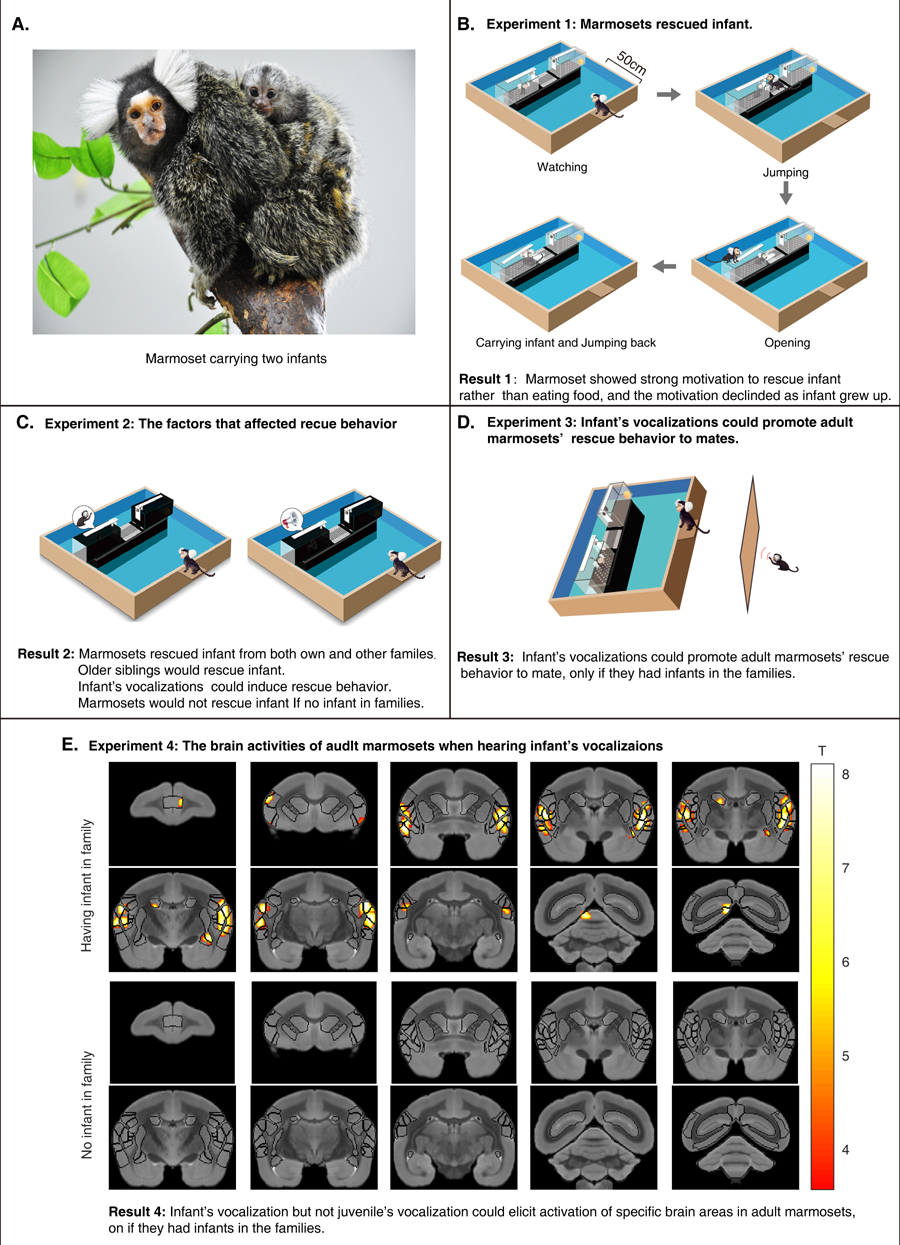Time:2020-08-21
A recent study published in Current Biology demonstrated that having infants in the family group could promote altruistic behavior of marmoset. This work was performed by researchers in Dr. GONG Neng’s team and Dr. Liang Zhifeng’s lab at the Institute of Neuroscience, State Key Laboratory of Neuroscience, Center for Excellence in Brain Science and Intelligence Technology of the Chinese Academy of Sciences.
Altruistic behavior is the unselfish behavior that could benefit others but not oneself, which is very common and a cornerstone of our harmonious society. However, some mental illnesses, such as autism and antisocial personality disorder were often accompanied by abnormally altruistic behavior. Therefore, evaluation of altruistic behavior and exploring its neural basis can improve our understanding of these illnesses and may provide new clues to therapies. Previous studies in altruistic behavior were mainly performed in human with noninvasive techniques, and very few were done in rodents due to their relatively simple social behavior and uncommon altruistic behavior. Therefore, an appropriate animal model for study altruistic behavior is an urgent need. Common marmoset (Callithrix jacchus), one kind of New World monkeys, has attracted much attention as a useful animal model in neuroscience (Figure 1A). They naturally live in monogamous family groups, exhibit cooperative breeding and rich pro-social behaviors, such as sharing food with others. These features indicate that marmoset may be a useful non-human primate model for studying altruistic behavior.
In this study, the authors established a novel rescue paradigm to evaluate marmoset’s altruistic behavior and found that marmoset parents and older siblings show strong motivation to rescue young infants rather than their favorite food (Figure 1B). This infant-rescue behavior declined as infants grew up, and marmoset parents did not rescue juvenile marmosets beyond 2 months of age. Infant calls alone could trigger these parents' rescue behaviors. The marmoset parents showed little rescue of each other, but young infants or infant calls could also induce parents' mutual rescue. Moreover, these infant- and mate- rescue behaviors occurred only in family groups that currently had young infants (Figures1C and 1D). To explore the underlying neural mechanism, the authors performed functional magnetic resonance imaging (fMRI) on awaked marmosets.
They found that infant’s vocalization compared to its scrambled version, but not juvenile’s vocalization, could elicit activation of specific brain areas including auditory and insular cortices in adult marmoset parents currently having infant in their family groups, while such activation was absent in marmosets not having infants (Figure 1E). This work showed that marmoset could be a useful non-human primate model to study altruistic behavior, and demonstrated a specific infant-induced rescue behavior in marmoset families. Such infant-induced modification of neural activity offers a window for examining the neural basis of altruistic behaviors in marmoset monkeys.
This work titled “Having infants in the family group promotes altruistic behavior of marmoset monkeys” was published online in Current Biology on August 20, 2020. The work was completed by graduate students HUANG Junfeng and assistant experimentalist CHENG Xiaochun supervised by Dr. GONG Neng and Dr. LIANG Zhifeng. ZHANG Shikun, LI Xuebo and CHANG Liangtang provided technical support, and Dr. POO Muming provided helpful discussions and insightful comments. This work was supported by Chinese Academy of Science, National Natural Science Foundation and Shanghai Municipal Government.

Figure 1. Marmoset parents showed strong motivation to rescued infant marmoset. (Image by CEBSIT)
(A) An adult marmoset carried two infants.
(B) The schematic drawing and imaging of the behavior paradigm. Marmoset parents opened the door, and then carried the infant and jumped back to the home cage
(C) Infant’s vocalization induced adult marmoset’s rescue behavior to infant.
(D) Infant’s vocalization enhanced the mutual rescue rate between mates living with infant in their family groups.
(E) Infant’s vocalization activated a large-scale brain area, such as auditory and insular cortices, in adult marmosets living with infant in their family groups.
AUTHOR CONTACT:
GONG Neng
Center for Excellence in Brain Science and Intelligence Technology, Chinese Academy of Sciences, Shanghai, China.
E-mail: ngong@ion.ac.cn
LIANG Zhifeng
Center for Excellence in Brain Science and Intelligence Technology, Chinese Academy of Sciences, Shanghai, China.
E-mail: zliang@ion.ac.cn
 附件下载:
附件下载: